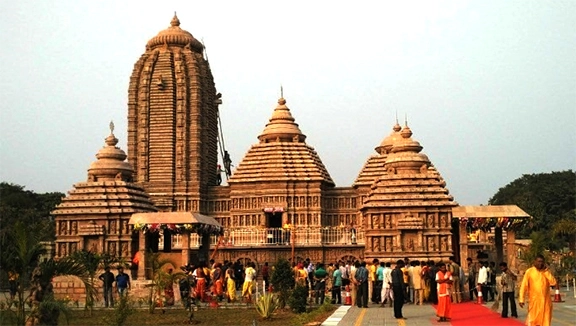Indian Heritage & Culture
Puri Heritage Corridor Project
- 27 May 2022
- 6 min read
For Prelims: Jaganath temple, Puri Heritage Corridor Project, ABADHA Scheme, AMSAR Act
For Mains: Preservation of Heritage sites, Controversies in the Excavation Projects, Temple Architecture of India, AMSAR Act
Why in News?
The Odisha government’s ambitious temple corridor project in Puri has become a subject of political controversy.
What is the Puri Heritage Corridor Project?
- It is a redevelopment project of the Odisha government in Puri to create an international heritage site, including the Jagannath temple. Though conceived in 2016, it was unveiled in December 2019.
- Under the umbrella project falls the Shree Jagannatha Heritage Corridor (SJHC) or the Shree Mandira Parikrama Project, for the revamp of the area around the temple.
- The project includes Shree Jagannath Temple Administration (SJTA) building redevelopment, a 600-capacity Srimandir reception centre, Puri Lake, Musa River revival plan, etc.
- The Odisha government has listed three objectives for the revamp of the area around the temple- the security of the temple, the safety of devotees, and the creation of a religious atmosphere for devotees.
- The government allotted funds for the Project from its Augmentation of Basic Amenities and Development of Heritage and Architecture at Puri (ABADHA) scheme.
- The ABADHA scheme includes Land Acquisition Charges/Re-habitation& Resettlement/ Road Improvement for providing better facilities in & around Shree Jagannath Temple.
Why has the Project become a Subject of Controversy?
- Experts and members of civil society objected to the use of heavy machinery for digging, citing the possibility of an adverse impact on the 12th Century temple.
- Questions started being raised about whether the construction around the temple had the due permissions and clearances.
- The Jagannath temple has been designated a monument of national importance by the Archaeological Survey of India and is a centrally protected monument.
- Massive demolition and construction works are taking place within a 100 and 200-meter area of the temple which is prohibited by the Ancient Monuments and Archaeological Sites and Remains (Amendment and Validation) Act (AMSAR) 2010.
What is the Ancient Monuments and Archaeological Sites and Remains (Amendment and Validation) Act (AMSAR) 2010?
- As per the AMSAR (Amendment and Validation) Act, construction is prohibited within a 100-meter periphery of a protected area.
- The area extending to 200 meters around the monument in all directions is called a regulated area.
- As per the provisions of the AMSAR Act, the National Monuments Authority (NMA), set up in 2011 under the Ministry of Culture, is charged with protecting and preserving ASI-protected sites by managing the prohibited and regulated area in the periphery of such a site.
- If construction has to be undertaken in a regulated or prohibited area, permission from the NMA is required.
- The term “construction” as defined in the AMSAR Act does not include the construction of public toilets, urinals, and “similar conveniences”.
- It also does not include works for the supply of water, electricity or “provision of similar facilities for publicity”.
- Besides, an impact assessment is also required to be done by the NMA before development around a monument if the built-up area of the monument is beyond 5,000 square meters.
What are the Features of Jagannath Temple?
- The temple is believed to be constructed in the 12th century by King Anatavarman Chodaganga Deva of the Eastern Ganga Dynasty.
- Jagannath Puri temple is called ‘Yamanika Tirtha’ where, according to the Hindu beliefs, the power of ‘Yama’, the god of death has been nullified in Puri due to the presence of Lord Jagannath.
- This temple was called the “White Pagoda” and is a part of Char Dham pilgrimages (Badrinath, Dwaraka, Puri, Rameswaram).
- There are four gates to the temple- Eastern ‘Singhdwara’ which is the main gate with two crouching lions, Southern ‘Ashwadwara’, Western 'Vyaghra Dwara and Northern ‘Hastidwara’. There is a carving of each form at each gate.
- In front of the entrance stands the Aruna stambha or sun pillar, which was originally at the Sun Temple in Konark.
Other Important Monuments of Odisha
- Konark Sun Temple (UNESCO World Heritage Site)
- Lingaraj Temple
- Tara Tarini Temple
- Udaygiri and Khandagiri Caves
UPSC Civil Services Examination, Previous Year Questions
Q. Match List I with List II and select the correct answer using the code given below the lists: (2009)
| List I | List II |
| (Famous Temple) | (State) |
| A. Vidyashankara temple | 1. Andhra Pradesh |
| B. Rajarani temple | 2. Karnataka |
| C. Kandariya Mahadeo | 3. Madhya Pradesh |
| D. Bhimesvara temple | 4. Orissa |
Code: A B C D
(a) 2 4 3 1
(b) 2 3 4 1
(c) 1 4 3 2
(d) 1 3 4 2
Ans: (a)





